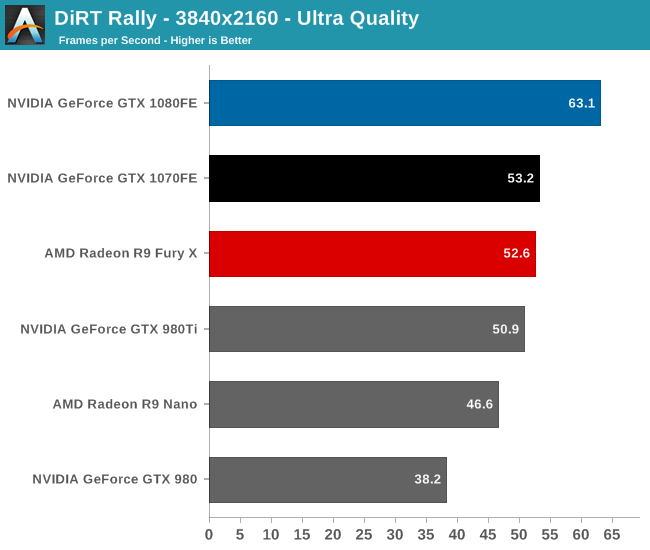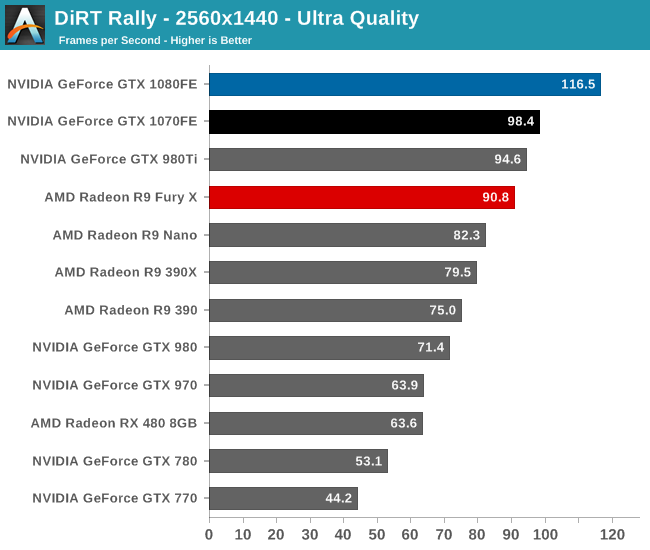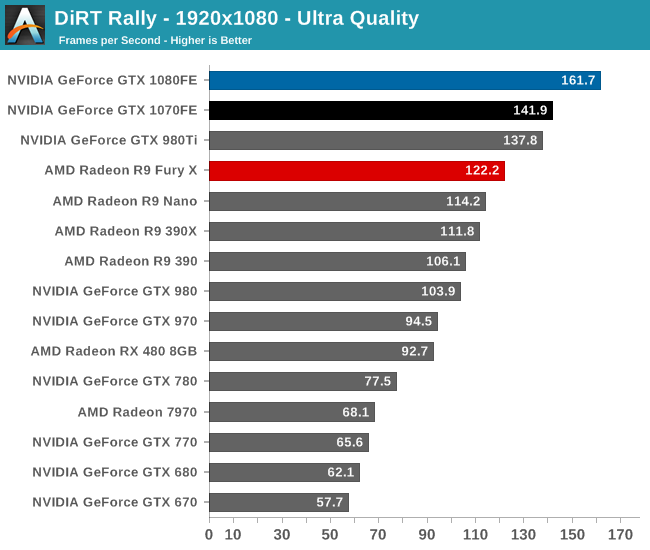The NVIDIA GeForce GTX 1080 & GTX 1070 Founders Editions Review: Kicking Off the FinFET Generation
by Ryan Smith on July 20, 2016 8:45 AM ESTDiRT Rally
For the racing game in our benchmark suite we have Codemasters’ DiRT Rally. Codemasters continues to set the bar for graphical fidelity in racing games, delivering realistic looking environments with layered with additional graphical effects. Based on their in-house EGO engine, DiRT Rally includes a number of DirectCompute based compute shader effects, and while it’s not the most punishing game in our suite, it still takes a very good card to sustain the 60fps frame rate that driving games are best played at.



Once again, the GTX 1080 is uncontested. Better still, it can crack 60fps at 4K, so gamers there won’t need to make any tradeoffs. And 1440p gamers with high refresh rate monitors should find that the card can come reasonably close to their refresh rate limit.
GTX 1070 is in turn solidly in second place, coming in around 4% ahead of the GTX 980 Ti. However because it’s targeting a level of performance only slightly ahead of the best of the last generation cards, we do see the 28nm Radeon Fury X hang on decently well at 4K, before the GTX 1070 pulls farther ahead at lower resolutions.










200 Comments
View All Comments
Ryan Smith - Wednesday, July 20, 2016 - link
Thanks.Eden-K121D - Wednesday, July 20, 2016 - link
Finally the GTX 1080 reviewguidryp - Wednesday, July 20, 2016 - link
This echoes what I have been saying about this generation. It is really all about clock speed increases. IPC is essentially the same.This is where AMD lost out. Possibly in part the issue was going with GloFo instead of TSMC like NVidia.
Maybe AMD will move Vega to TSMC...
nathanddrews - Wednesday, July 20, 2016 - link
Curious... how did AMD lose out? Have you seen Vega benchmarks?TheinsanegamerN - Wednesday, July 20, 2016 - link
its all about clock speed for Nvidia, but not for AMD. AMD focused more on ICP, according to them.tarqsharq - Wednesday, July 20, 2016 - link
It feels a lot like the P4 vs Athlon XP days almost.stereopticon - Wednesday, July 20, 2016 - link
My favorite era of being a nerd!!! Poppin' opterons into s939 and pumpin the OC the athlon FX levels for a fraction of the price all while stompin' on pentium. It was a good (although expensive) time to a be a nerd... Besides paying 100 dollars for 1gb of DDR500. 6800gs budget friendly cards, and ATi x1800/1900 super beasts.. how i miss the dayseddman - Thursday, July 21, 2016 - link
Not really. Pascal has pretty much the same IPC as Maxwell and its performance increases accordingly with the clockspeed.Pentium 4, on the other hand, had a terrible IPC compared to Athlon and even Pentium 3 and even jacking its clockspeed to the sky didn't help it.
guidryp - Wednesday, July 20, 2016 - link
No one really improved IPC of their units.AMD was instead forced increase the unit count and chip size for 480 is bigger than the 1060 chip, and is using a larger bus. Both increase the chip cost.
AMD loses because they are selling a more expensive chip for less money. That squeezes their unit profit on both ends.
retrospooty - Wednesday, July 20, 2016 - link
"This echoes what I have been saying about this generation. It is really all about clock speed increases. IPC is essentially the same."- This is a good thing. Stuck on 28nm for 4 years, moving to 16nm is exactly what Nvidias architecture needed.